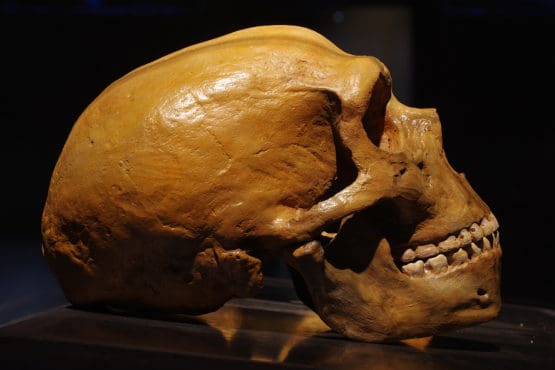A genome by itself is like a recipe without a chef – full of important information, but in need of interpretation. So, even though we have sequenced genomes of our nearest extinct relatives – the Neanderthals and the Denisovans – there remain many unknowns regarding how differences in our genomes actually lead to differences in physical traits.
“When we’re looking at archaic genomes, we don’t have all the layers and marks that we usually have in samples from present-day individuals that help us interpret regulation in the genome, like RNA or cell structure,” said David Gokhman, a postdoctoral fellow in biology at Stanford University.
“We just have the naked DNA sequence, and all we can really do is stare at it and hope one day we’d be able to understand what it means,” he said.
Motivated by such hopes, a team of researchers at Stanford and the University of California, San Francisco (UCSF), have devised a new method to harvest more information from the genomes of archaic humans to potentially reveal the physical consequences of genomic differences between us and them.
Their work, published April 22 in eLife, focused on sequences related to gene expression – the process by which genes are activated or silenced, which determines when, how and where DNA’s instructions are followed. Gene expression tends to be the genetic detail that determines physical differences between closely related groups.
Starting with 14,042 genetic variants unique to modern humans, the researchers found 407 that specifically contribute to differences in gene expression between modern and archaic humans. In further analysis, they determined that the differences were more likely to be associated with the vocal tract and the cerebellum, which is the part of our brain that receives sensory information and controls voluntary movement, including walking, coordination, balance and speech.
“It just seems so implausible that you could make a call like, ‘I think the voice box evolved,’ from the information we have,” said Dmitri Petrov, the Michelle and Kevin Douglas Professor in the School of Humanities and Sciences, who is co-senior author of the paper with Gokhman and Nadav Ahituv, a professor of bioengineering at UCSF. “The predictions are almost science fiction. If five years ago, somebody told me that this would be possible, I would not have put much money on it.”
The path to modern humans
With such a large number of variants to examine, the researchers relied on a technique called a “massively parallel reporter assay” to test which sequences actually affect gene regulation. Their version of this technique, which was developed by Ahituv, involves packaging the DNA sequence variant into a “reporter gene” inside a virus. That virus is then put into a cell. If that variant affects gene expression, the reporter gene produces a barcoded molecule that identifies what DNA sequence it came from. The barcode allows the researchers to scan the products of a large number of variants at once.
Essentially, the whole process imitates an abridged version of how each variant would play out in a cell in real life and reports the results.
Lana Harshman, a graduate student at UCSF and co-lead author of the paper, infected three types of cells with the team’s variant packages. These cells were related to the brain, skeleton and early development – subjects that are most likely to reveal evolutionary differences between us and our most recent ancestors. Carly Weiss, a postdoctoral scholar in the Petrov lab and co-lead author of the paper, analyzed the results of these experiments.
In total, the researchers found 407 sequences that represented a change in expression in modern humans compared to our predecessors. Among that list, genes that affect the cerebellum and genes that affect the voice box, pharynx, larynx and vocal cords seem to be overrepresented.
“This would suggest some kind of rapid evolution of those organs or some kind of a path that is specific to modern humans,” said Gokhman. The next step, he added, would be trying to understand more about these sequences and the roles they played in the evolution of modern humans.
Even with those unknowns, this technique by itself is a significant advance for evolutionary research, said Petrov.
“This goes beyond the sequencing of the DNA from the Neanderthal and Denisovan bones. This begins to put meaning on those differences,” said Petrov. “It’s an important conceptual step from just the sequence – no tissue, no cells – to biological information and will enable many future studies.”
Hunter Fraser, associate professor of biology at Stanford, and Fumitaka Inoue (UCSF) are also co-authors of the paper. Fraser is also a member of Stanford Bio-X, the Maternal & Child Health Research Institute (MCHRI) and the Stanford Cancer Institute. Petrov is also a member of Stanford Bio-X and the Maternal & Child Health Research Institute (MCHRI), and an affiliate of the Stanford Woods Institute for the Environment.
This research was funded by Human Frontier, Rothschild and Zuckerman fellowships; the National Human Genome Research Institute; the National Institute of Mental Health; the Uehara Memorial Foundation; and the Stanford Center for Computational, Evolutionary and Human Genomics (CEHG).
To read all stories about Stanford science, subscribe to the biweekly Stanford Science Digest.
Media Contacts
Taylor Kubota, Stanford News Service: (650) 724-7707; [email protected]
Robin Marks, UCSF: (415) 663-6768; [email protected]


